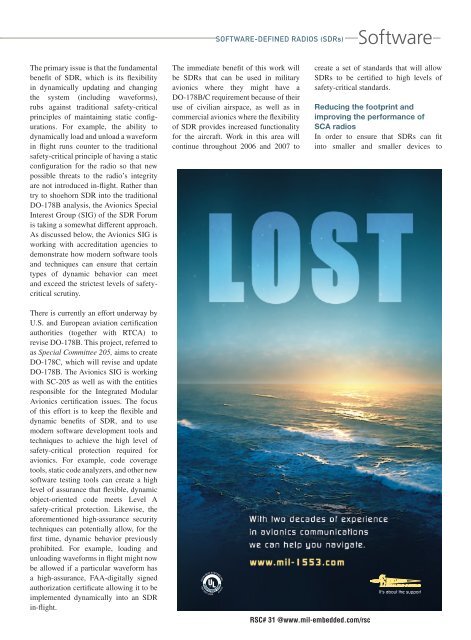Military Embedded Systems Summer 2006
Military Embedded Systems Summer 2006
Military Embedded Systems Summer 2006
You also want an ePaper? Increase the reach of your titles
YUMPU automatically turns print PDFs into web optimized ePapers that Google loves.
Software-Defined Radios (SDRs)<br />
Software<br />
The primary issue is that the fundamental<br />
benefit of SDR, which is its flexibility<br />
in dynamically updating and changing<br />
the system (including waveforms),<br />
rubs against traditional safety-critical<br />
principles of maintaining static configurations.<br />
For example, the ability to<br />
dynamically load and unload a waveform<br />
in flight runs counter to the traditional<br />
safety-critical principle of having a static<br />
configuration for the radio so that new<br />
possible threats to the radio’s integrity<br />
are not introduced in-flight. Rather than<br />
try to shoehorn SDR into the traditional<br />
DO-178B analysis, the Avionics Special<br />
Interest Group (SIG) of the SDR Forum<br />
is taking a somewhat different approach.<br />
As discussed below, the Avionics SIG is<br />
working with accreditation agencies to<br />
demonstrate how modern software tools<br />
and techniques can ensure that certain<br />
types of dynamic behavior can meet<br />
and exceed the strictest levels of safetycritical<br />
scrutiny.<br />
The immediate benefit of this work will<br />
be SDRs that can be used in military<br />
avionics where they might have a<br />
DO-178B/C requirement because of their<br />
use of civilian airspace, as well as in<br />
commercial avionics where the flexibility<br />
of SDR provides increased functionality<br />
for the aircraft. Work in this area will<br />
continue throughout <strong>2006</strong> and 2007 to<br />
create a set of standards that will allow<br />
SDRs to be certified to high levels of<br />
safety-critical standards.<br />
Reducing the footprint and<br />
improving the performance of<br />
SCA radios<br />
In order to ensure that SDRs can fit<br />
into smaller and smaller devices to<br />
There is currently an effort underway by<br />
U.S. and European aviation certification<br />
authorities (together with RTCA) to<br />
revise DO-178B. This project, referred to<br />
as Special Committee 205, aims to create<br />
DO-178C, which will revise and update<br />
DO-178B. The Avionics SIG is working<br />
with SC-205 as well as with the entities<br />
responsible for the Integrated Modular<br />
Avionics certification issues. The focus<br />
of this effort is to keep the flexible and<br />
dynamic benefits of SDR, and to use<br />
modern software development tools and<br />
techniques to achieve the high level of<br />
safety-critical protection required for<br />
avionics. For example, code coverage<br />
tools, static code analyzers, and other new<br />
software testing tools can create a high<br />
level of assurance that flexible, dynamic<br />
object-oriented code meets Level A<br />
safety-critical protection. Likewise, the<br />
aforementioned high-assurance security<br />
techniques can potentially allow, for the<br />
first time, dynamic behavior previously<br />
prohibited. For example, loading and<br />
unloading waveforms in flight might now<br />
be allowed if a particular waveform has<br />
a high-assurance, FAA-digitally signed<br />
authorization certificate allowing it to be<br />
implemented dynamically into an SDR<br />
in-flight.<br />
ISO<br />
EXCALIBUR<br />
9001:2000<br />
SYSTEMS<br />
INC.<br />
A14771<br />
RSC# 31 @www.mil-embedded.com/rsc<br />
EXCALIBUR SYSTEMS<br />
It’s about the support
















